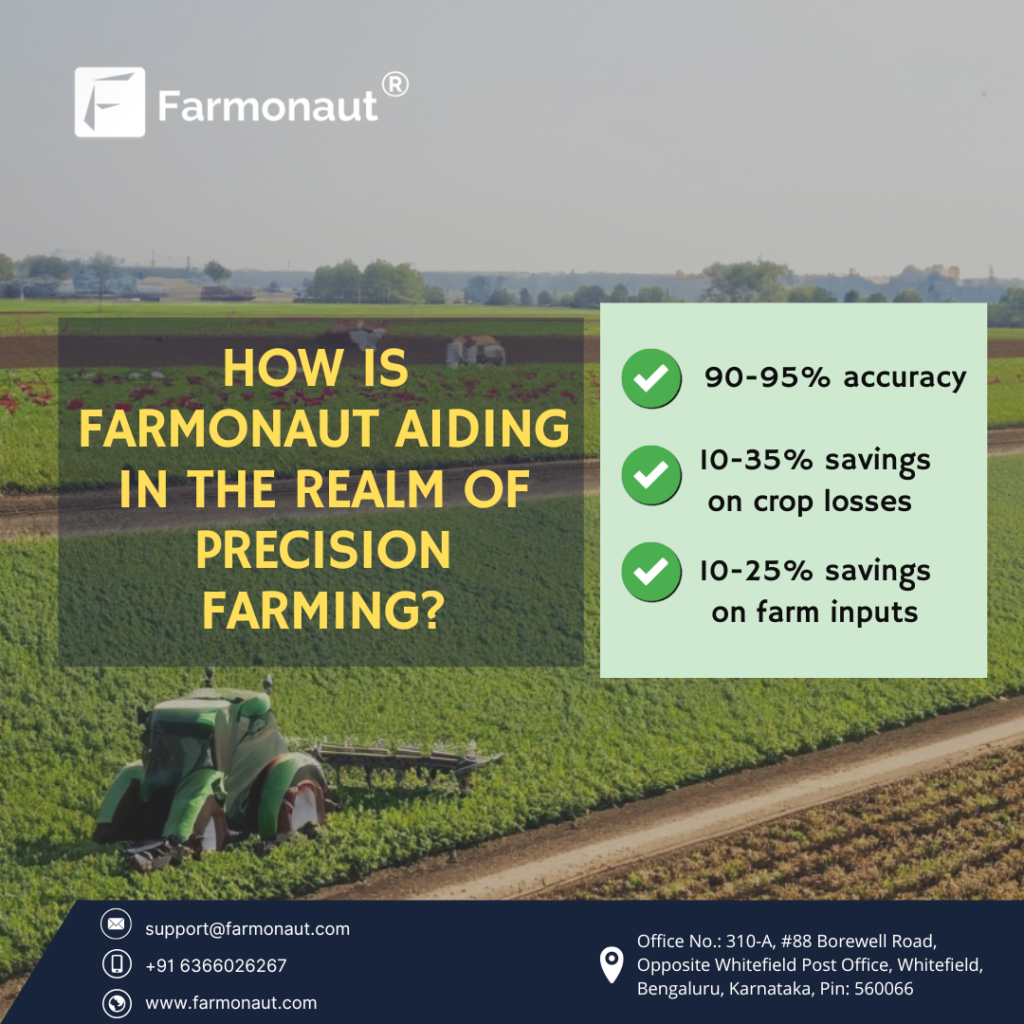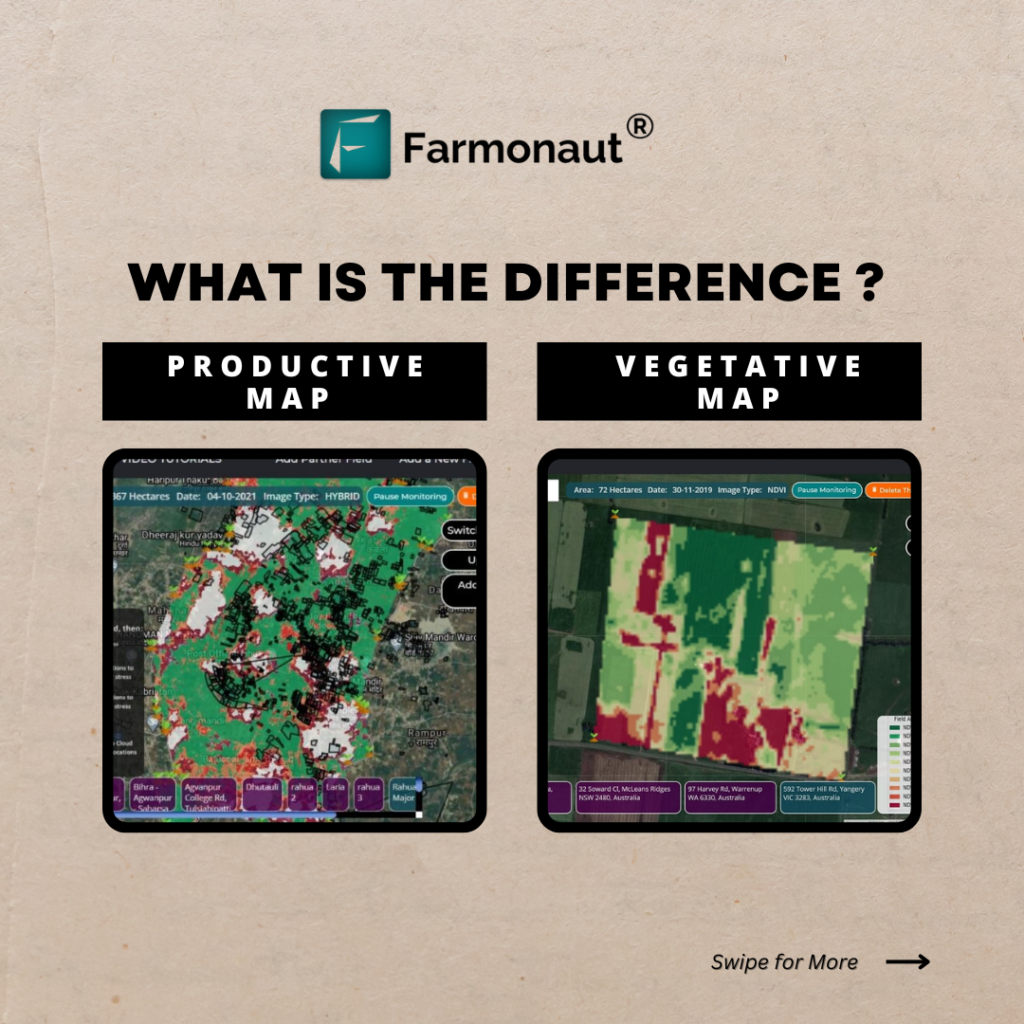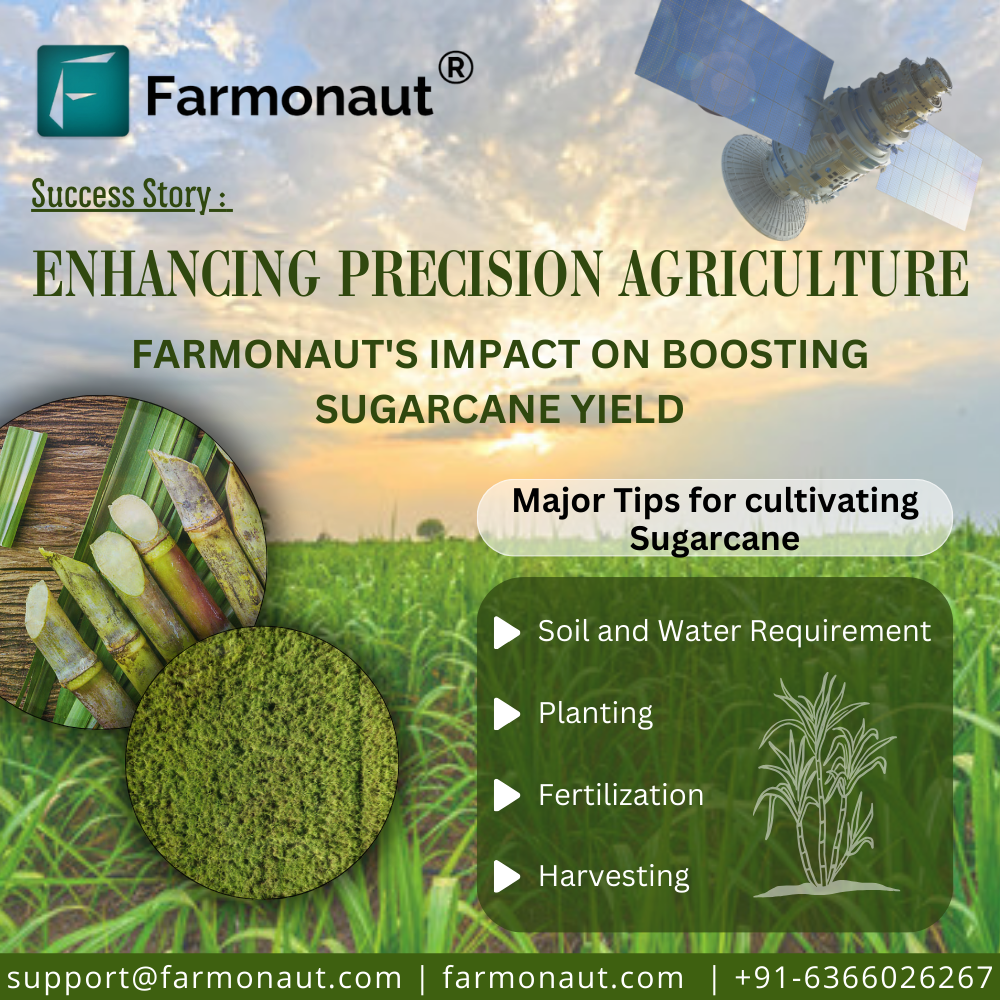The Ultimate Guide to Palm Oil Tree Farming: Maximizing Profits and Sustainability

Welcome to our comprehensive guide on palm oil tree farming! At Farmonaut, we’re committed to helping farmers and agribusinesses optimize their operations through cutting-edge technology and data-driven insights. In this blog post, we’ll dive deep into the world of palm oil tree farming, exploring everything from cultivation techniques to sustainable practices and profit maximization strategies.
Table of Contents
- Introduction to Palm Oil Tree Farming
- The Importance of Palm Oil in Global Agriculture
- Setting Up Your Palm Oil Tree Farm
- Best Practices for Palm Oil Tree Cultivation
- Sustainable Palm Oil Farming Techniques
- Maximizing Profits in Palm Oil Tree Farming
- Challenges in Palm Oil Tree Farming and How to Overcome Them
- The Role of Technology in Modern Palm Oil Tree Farming
- Future Trends in Palm Oil Tree Farming
- FAQs
1. Introduction to Palm Oil Tree Farming
Palm oil tree farming has become a significant contributor to the global agricultural economy. As we delve into this topic, it’s crucial to understand that a palm tree farm dedicated to oil production is not just a plantation but a complex ecosystem that requires careful management and sustainable practices.
An oil palm tree farm typically consists of rows upon rows of Elaeis guineensis, the African oil palm, which is the primary species used for commercial palm oil production. These trees can grow up to 20 meters tall and have a productive lifespan of 25-30 years, making them a long-term investment for farmers and agribusinesses.
2. The Importance of Palm Oil in Global Agriculture
Palm oil has become an indispensable commodity in the global market. It’s used in a wide range of products, from food and cosmetics to biofuels. The versatility and high yield of palm oil trees have made them a popular choice for farmers worldwide. Here are some key reasons why palm oil tree farming has gained such prominence:
- High yield per hectare compared to other vegetable oils
- Versatile uses in various industries
- Growing global demand
- Economic importance for many developing countries
3. Setting Up Your Palm Oil Tree Farm
Establishing an oil farm tree plantation requires careful planning and consideration of various factors. Here’s a step-by-step guide to help you get started:
- Site Selection: Choose a location with suitable climate, soil type, and topography. Oil palms thrive in tropical regions with consistent rainfall and temperatures between 24-32°C (75-90°F).
- Land Preparation: Clear the land and prepare it for planting. This may involve leveling, drainage system installation, and soil analysis.
- Seedling Selection: Choose high-quality, disease-resistant seedlings from reputable nurseries.
- Planting: Plant the seedlings in a triangular pattern to maximize land use, typically with 138-143 trees per hectare.
- Infrastructure Development: Set up irrigation systems, access roads, and processing facilities.
At Farmonaut, we understand the importance of precise planning in establishing a successful palm oil tree farm. Our satellite-based crop monitoring system can help you assess land suitability and monitor your plantation’s progress from the very beginning. Learn more about our services here.
4. Best Practices for Palm Oil Tree Cultivation
To ensure the success of your farm oil tree plantation, it’s essential to follow best practices in cultivation. Here are some key aspects to consider:
- Soil Management: Maintain optimal soil pH (4.5-6.0) and nutrient levels through regular testing and appropriate fertilization.
- Water Management: Ensure proper drainage and irrigation to maintain optimal soil moisture levels.
- Pest and Disease Control: Implement integrated pest management strategies to protect your trees from common pests and diseases.
- Pruning and Harvesting: Regular pruning helps maintain tree health and facilitates easier harvesting. Harvest ripe fruit bunches every 10-14 days.
- Record Keeping: Maintain detailed records of planting, fertilization, harvesting, and yield data to inform future decision-making.
Our Jeevn AI Advisory System can provide personalized recommendations for your palm tree farm, helping you optimize these practices based on real-time data and expert insights.
5. Sustainable Palm Oil Farming Techniques

Sustainability is a crucial aspect of modern palm oil tree farming. As stewards of the land, we must ensure that our farming practices protect the environment and support local communities. Here are some sustainable techniques for your oil palm tree farm:
- Zero Deforestation: Avoid clearing primary forests or areas of high conservation value for plantation expansion.
- Biodiversity Conservation: Maintain wildlife corridors and buffer zones around water bodies to protect local ecosystems.
- Integrated Pest Management: Use biological control methods and reduce reliance on chemical pesticides.
- Soil Conservation: Implement cover cropping and erosion control measures to protect and enhance soil health.
- Water Management: Implement efficient irrigation systems and water recycling practices to minimize water usage.
- Community Engagement: Involve local communities in the farming process and support social development initiatives.
At Farmonaut, we’re committed to promoting sustainable agriculture. Our carbon footprinting feature can help you track and reduce your farm’s environmental impact, ensuring that your palm oil tree farm meets the highest standards of sustainability.
6. Maximizing Profits in Palm Oil Tree Farming
Profitability is a key concern for any farm tree operation, especially in the competitive palm oil industry. Here are some strategies to maximize your profits:
- Optimize Yield: Use high-yielding varieties and implement best practices in cultivation to maximize fruit production.
- Improve Efficiency: Invest in efficient harvesting and processing equipment to reduce labor costs and increase oil extraction rates.
- Diversify Products: Consider producing value-added products like palm kernel oil or biomass energy from waste materials.
- Implement Precision Agriculture: Use technologies like satellite monitoring and AI-driven advisory systems to optimize resource use and increase productivity.
- Certifications: Obtain sustainability certifications like RSPO to access premium markets and potentially higher prices.
- Risk Management: Implement strategies to mitigate risks from price fluctuations, weather events, and pests/diseases.
Our satellite-based crop health monitoring system can help you identify areas of your oil farm tree plantation that need attention, allowing you to address issues promptly and maintain optimal productivity. Learn more about our API services here.
7. Challenges in Palm Oil Tree Farming and How to Overcome Them
While palm oil tree farming can be highly profitable, it also comes with its share of challenges. Here are some common issues faced by palm tree farm operators and strategies to overcome them:
- Climate Variability: Use climate-resilient varieties and implement water management strategies to mitigate the effects of drought or excessive rainfall.
- Pest and Disease Outbreaks: Implement integrated pest management and maintain biodiversity to create a more resilient ecosystem.
- Labor Shortages: Invest in mechanization and adopt technologies that can reduce labor requirements.
- Market Volatility: Diversify your product range and explore long-term contracts to stabilize income.
- Sustainability Concerns: Adopt best practices in sustainable farming and obtain relevant certifications to address environmental and social concerns.
Our Jeevn AI Advisory System can help you anticipate and prepare for many of these challenges, providing real-time insights and expert recommendations tailored to your specific palm oil tree farm.
8. The Role of Technology in Modern Palm Oil Tree Farming
Technology is revolutionizing the way we approach palm oil tree farming. At Farmonaut, we’re at the forefront of this technological revolution, offering cutting-edge solutions for modern farm tree operations. Here’s how technology is transforming the industry:
- Satellite Monitoring: Our satellite-based crop health monitoring system provides real-time insights into vegetation health, soil moisture levels, and other critical metrics.
- AI-Driven Advisory: Our Jeevn AI system analyzes data from various sources to provide personalized recommendations for farm management.
- Blockchain Traceability: We offer blockchain-based solutions to ensure transparency and traceability in the palm oil supply chain.
- Precision Agriculture: GPS-guided machinery and drones enable precise application of inputs and targeted interventions.
- IoT Sensors: Internet of Things (IoT) devices can monitor soil conditions, weather patterns, and tree health in real-time.
Here’s how Farmonaut’s Satellite System compares to drone and IoT-based farm monitoring:
| Feature | Farmonaut Satellite System | Drone-based Monitoring | IoT-based Monitoring |
|---|---|---|---|
| Coverage Area | Large scale (thousands of hectares) | Limited (tens of hectares per flight) | Dependent on sensor placement |
| Frequency of Data Collection | Regular (every few days) | As needed (manual flights required) | Continuous |
| Initial Investment | Low | High (drone purchase, training) | Medium to High (sensor network setup) |
| Operational Costs | Low | Medium (maintenance, pilot costs) | Low to Medium (maintenance, data plans) |
| Data Processing | Automated (AI-driven) | Manual or semi-automated | Automated |
| Weather Dependency | Low (can penetrate clouds) | High (affected by wind, rain) | Low |
| Regulatory Compliance | Easy (no flight permissions needed) | Complex (flight permissions required) | Moderate (depends on local regulations) |
To learn more about how our technology can benefit your oil palm tree farm, download our mobile app for Android or iOS.
9. Future Trends in Palm Oil Tree Farming
As we look to the future of palm oil tree farming, several trends are likely to shape the industry:
- Genetic Improvements: Development of higher-yielding, disease-resistant varieties through advanced breeding techniques.
- Vertical Integration: More farmers and companies integrating downstream processing to capture additional value.
- Circular Economy Practices: Increased focus on utilizing all parts of the palm fruit and tree for various products and energy generation.
- Agroforestry Systems: Integration of palm oil trees with other crops or livestock to create more diverse and resilient farming systems.
- Carbon Markets: Potential for palm oil farmers to participate in carbon credit schemes through sustainable farming practices.
At Farmonaut, we’re continually evolving our technology to meet these future challenges and opportunities. Our API services, detailed in our developer documentation, allow for seamless integration of our cutting-edge solutions into your existing farm management systems.
10. FAQs
Q: How long does it take for an oil palm tree to start producing fruit?
A: Oil palm trees typically start producing fruit 2-3 years after planting, with full production reached at 5-7 years.
Q: What is the average lifespan of an oil palm tree?
A: The economic lifespan of an oil palm tree is typically 25-30 years, after which productivity declines significantly.
Q: How often are oil palm trees harvested?
A: Harvesting occurs year-round, usually every 10-14 days, as fruit bunches ripen continuously.
Q: What are the main environmental concerns associated with palm oil farming?
A: The main concerns include deforestation, loss of biodiversity, and greenhouse gas emissions from land conversion.
Q: How can I make my palm oil farm more sustainable?
A: Implement best practices such as zero deforestation, integrated pest management, and community engagement. Consider obtaining sustainability certifications like RSPO.
Q: How can Farmonaut’s technology help my palm oil farm?
A: Our satellite monitoring and AI advisory systems can help optimize resource use, improve crop health, and increase overall productivity while promoting sustainable practices.
Conclusion
Palm oil tree farming is a complex but rewarding endeavor that plays a crucial role in the global agricultural economy. By adopting sustainable practices, leveraging cutting-edge technology, and staying informed about industry trends, farmers and agribusinesses can maximize their profits while minimizing environmental impact.
At Farmonaut, we’re committed to supporting palm oil tree farmers with our advanced satellite-based farm management solutions. Our technology enables precision agriculture at an affordable price point, helping farmers of all scales to optimize their operations and increase productivity.
Ready to take your palm oil tree farm to the next level? Subscribe to Farmonaut today and experience the power of data-driven farming:
Join us in shaping the future of sustainable and profitable palm oil tree farming. Together, we can cultivate success while nurturing our planet.












